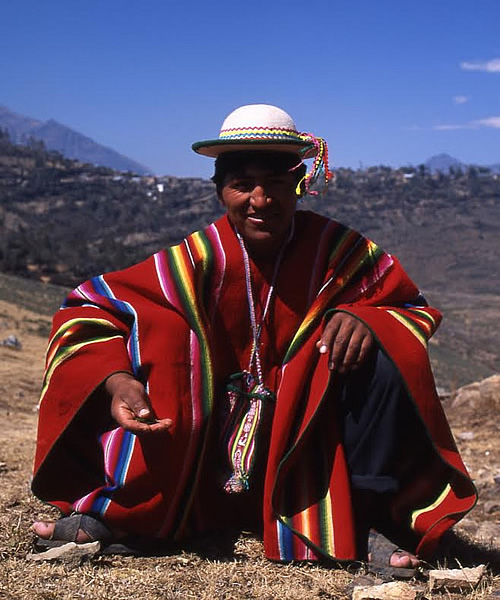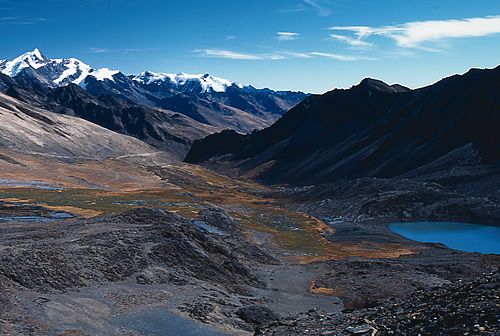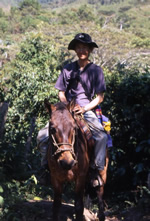Exploring Bolivia’s Cordillera Apolobamba
An Inca Trail Less Traveled
Article and Photos by Martin Li

|
|
A Kallawaya healer-fortuneteller from Curva, Bolivia.
|
With Peru’s celebrated “Inca Trail” to Machu Picchu straining under the weight of trekkers (you need to book a starting slot several months in advance), savvy adventurers are searching for alternative Inca
paths to explore. Bolivia offers several Inca trails, of which the route through the Cordillera Apolobamba is arguably the best and certainly one of the least trekked. High, wild, and remote, the Apolobamba trek offers breathtaking Andean wilderness,
a glimpse into the heart of ancient cultures, and guaranteed sightings of rare wildlife including alpacas, vicuñas, and majestic condors.
The trail begins in the peaceful village of Curva, the heart of the ancient Kallawaya culture. The Kallawayas were the mystical healers and fortunetellers who treated Inca aristocracy, and their vibrant way of life survives
today. The guide for the journey was Paulino, a local Kallawaya. We climbed a crest out of Curva and the glaciated Apolobamba range immediately came into view. We passed sacred sites where Kallawayas sacrifice llamas to ask for Pachamama’s
blessing for harvests, work and health.
For two days we climbed toward Akhamani, the Kallawayas’ sacred mountain, its lower slopes carpeted with terraces and grazed by llamas, alpacas, and sheep. Ancient, stone-walled enclosures and thatched stone cottages
for local herders dotted the slopes.
In Jatumpampa, we caught trout from a tiny stream, which we ate for supper in the cozy interior of a Quechua house. We climbed steeply over dark rocks to two high passes and, as is the custom, placed white stones on their
summits to ask for good luck and strength.
Chased by low clouds drifting over the pass, we descended into a misty bleak wilderness. Dark, lichen-covered rocks towered above us in near-vertical cliff faces, some overlain by frozen waterfalls, until the landscape finally
started to mellow. We crossed an area of open country and reached “Inka Kancha,” a site once used by the Incas to graze animals, and which still bears the ruins of corrals.
Next morning, ice made it difficult to unzip the tents, as we emerged into a bitterly cold, although crisp, dry dawn. We could barely believe the sight of Akhamani bathed in brilliant morning sunlight against the backdrop
of a cloudless blue sky and nearly full moon.
Our journey took us over more high mountain passes with staggering vistas of the broad valleys and the cordillera’s snow-covered peaks beyond, past trout-filled lakes and occasional gold mines, and into pastoral scenes
of shepherds tending flocks of sheep.
We arrived in Pelechuco almost before we could see it through the mist. Most Apolobamba treks end here, although the scenery becomes even grander further north toward the magnificent, glaciated summits of Presidente and
Flor, and the Katantika Pass, which is marked by several turquoise lakes and some of the most breathtaking scenery in the Andes.

|
|
View from the Sunchulli Pass.
|
For More Info
You can trek the trail in either direction, although the trek is arguably better from south to north — Curva to Pelechuco. You can arrange Apolobamba treks with many La Paz tour agencies although it is cheaper to make
arrangements yourself in either Curva (or its satellite village of Lagunillas) or Pelechuco. Guides cost Bs70 ($10) per day and packhorses Bs60 ($8.50) per day. You will also need to buy food and bring camping equipment.
Guides recommend a 5-day itinerary, although the first two days of the “standard” south to north trek are very short. Ask to compress the first two days into one and use the extra day to continue to the breathtaking
Katantika Pass.
You can travel by bus from La Paz to the trailheads at Curva (10 hours) and Pelechuco (12 hours). Fares: $5-$6.
The trek stays mostly above 4,000 meters with several high passes reaching a maximum elevation of 5,100 meters. Make sure you acclimatize for several days before beginning the trek.

|
Martin Li studied physics at Cambridge. A keen skier, horserider and trekker, he has a passion for exploring the adventure and culture of the world’s great mountain regions, especially
the Himalayas, Alps and, above all, the Andean countries of South America. In 2000, he spent four months writing for The Bolivian Times in La Paz, covering diverse subjects ranging from privatization and the Bolivian stock market to cock
fighting.
Martin won the 2005 Wilderness Award for this expedition, and has subsequently given several lectures on the journey.
Martin’s other adventures have included riding a horse across the Namib Desert, trekking to Bhutan’s most sacred summit, close encounters with black bears in Alaska and rafting the thundering rapids of
Panama’s Rio Chiriqui. Martin is the author of Adventure Guide to Scotland and contributed to V!VA List Latin America. He lives in London and is a Fellow of the Royal Geographical Society.
|
|
